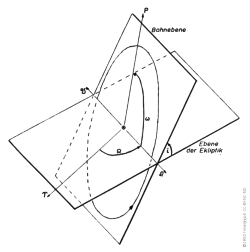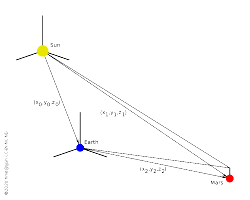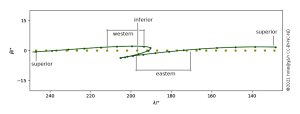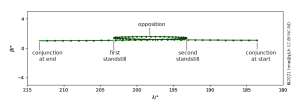
{ Practical astronomy | Astronomy | Planets | Planetary motion }
Planetary motion
Ephemerides are ephemeral data describing the motion of a celestial body. Simply put, they are a table of times, and the celestial position and distance at that time. Ephemeris and ephemerides are the singular and plural of the word, but ephemeris are also not really countable, so that both terms are used interchangeably and essentially have the same meaning.
As Earthlings we need ephemeris to tell us where in our sky the planets will be at a given time. But the movement in question is actually a combination of the planet's movement around the Sun and of the Earth around the Sun.
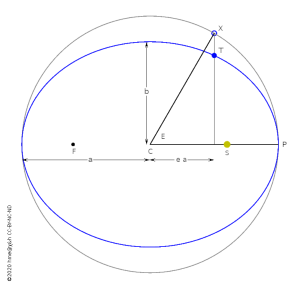
The elliptical Kepler orbit. For demonstration purposes, the eccentricity here is rather extreme at e = 0.6.
What is going on is discussed in detail in the section about the Sun. The Sun's gravity keeps each planet in an orbit around it. If the planet and Sun were alone with each other, and in Newtonian mechanics, this would be a Kepler orbit, i.e. an ellipse. However, each pair of planets also attracts each other a tiny bit, gravity travels between Sun and planet only at the speed of light, and Einstein has his own ideas of space and time. As a result, the Kepler ellipse is actually not precise enough for good ephemeris of the planets.
In the section about the Sun we presented the algorithm by Simon et al. (1994a) to take care of these problems. Our deliberations there were for the Earth's orbit around the Sun, although applied as the apparent orbit of the Sun around the Earth. The whole formalism applies for each of the other seven planets and its motion around the Sun, just with different parameters for their orbits.
The calculations still use Kepler elements and the iteration of the Kepler equation; it is just that the Kepler elements are not constant, but adjusted beforehand for the time in question. We recall here that the Kepler elements are:
- a
- Semi-major axis (in Gm or au). This is the long radius of the ellipse, also the average distance of the planet from the Sun.
- e
- Numeric eccentricity (dimensionless). This is zero for a circle, one for a parabola, and in between characterises how non-circular the ellipse is.
- n
- Mean daily motion (in °/d).
- ω
- Argument of perihelion (in °). This is the angle between the ascending node and the perihelion and describes the orientation of the ellipse in the orbital plane.
- i
- Inclination (in °). This is the inclination angle between the ecliptic and the orbital plane.
- Ω
- Longitude of ascending node (in °). This is the angle between the vernal equinox and the ascending node (where the orbital plane intersects the ecliptic).
In addition, time is parameterised as the mean anomaly M. Its value at a certain standard epoch T0 is usually listed as an orbital element and increases according to the mean daily motion n.
M(t) = M(T0) + n · (t − T0)
We briefly mention again, that in the literature we usually find ϖ = ω + Ω and L = M +ω + Ω. Those are less intuitive and also less useful for the calculations.
Because we want to know where the planet appears in the sky above Earth, we have to make calculations for two planets, the one being observed (P) and the Earth (E).
ME(t) = ME(T0,E)
+ nE · (t − T0,E)
MP(t) = MP(T0,P)
+ nP · (t − T0,P)
The Kepler equation
EX − eX · sin(EX) = MX
is solved iteratively to find the eccentric anomalies EE(t) and EP(t). From the angle E (see graph of the Kepler orbit for its meaning), we can calculate the rectangular, heliocentric coordinates in the orbital plane, oriented to the perihelion:
xS,X = aX · cos(EX)
− aX · eX
yS,X = aX · sin(EX)
· (1 − eX2)0.5
zS,X = 0
The remaining Kepler elements ω, i and Ω are just rotations of the coordinate system in space.
x1 = xS,X · cos(ωX)
− yS,X · sin(ωX)
y1 = yS,X · cos(ωX)
+ xS,X · sin(ωX)
z1 = zS,X
x2 = x1
y2 = y1 · cos(iX)
− z1 · sin(iX)
z2 = z1 · cos(iX)
+ y1 · sin(iX)
xhel,X = x2 · cos(ΩX)
− y2 · sin(ΩX)
yhel,X = y2 · cos(ΩX)
+ x2 · sin(ΩX)
zhel,X = z2
Having made the above calculations separately for Earth and planet, we finally find the geocentric position of the planet as the difference of the two heliocentric positions:
xgeo,P = xhel,P − xhel,E
ygeo,P = yhel,P − yhel,E
zgeo,P = zhel,P − zhel,E
Inner planets
The motion of a planet in the Earth's sky appears quite complex, because of the combination of the planet's motion around the Sun and of the Earth's motion around the Sun. The inner planets Mercury and Venus remain close to the Sun in our sky; Mercury is at most 28° from the Sun, Venus 47°. As such, observation of an inner planet is mostly limited to twilight or daylight. A synodic orbit of an inferior planet has four main events: superior and inferior conjunctions and greatest eastern and western elongations.
- At superior conjunction the Sun is situated between the Earth and the planet. The planet has a full phase and maximum distance from Earth. But it is invisible in the glare of the Sun.
- The planet then moves eastward (in direct motion, left for observers in the northern hemisphere) faster than the Sun does. It thus gains angular distance from the Sun and emerges from the solar glare into evening twilight. The planet also moves closer to the Earth, first slowly, then faster. The phase reduces.
- At greatest eastern elongation, the planet's angular speed has slowed down to the same as the Sun's. In return, the planet now approaches Earth at its fastest. The phase is half and the distance from the Earth already less than the Sun-Earth distance. Around this time is best to observe the planet in evening twilight.
- The planet continues to move eastward on the sky for a short while, but slower than the Sun. Then the planet will turn to move westward in retrograde motion. The planet moves closer to Earth, and on our sky closer to the Sun; the phase is a crescent that becomes thinner and thinner.
- At inferior conjunction the planet is between the Earth and the Sun. It is at its closest to the Earth. The phase is new. Mercury is impossible to observe in the Sun's glare; Venus may still be observable with caution and skill.
- The planet continues its westward motion for a while, then turns to resume eastward motion. It moves further away from the Earth, and on our sky also away from the Sun. The crescent phase becomes thicker. The planet emerges from the solar glare into morning twilight.
- At greatest western elongation, the planet's angular speed has increased enough to keep pace with the Sun. The planet now recedes from Earth at its fastest. The phase is half. Around this time is best to observe the planet in morning twilight.
- The planet continues its move away from the Earth, but now moves eastward faster than the Sun. When it catches up with the Sun, we have superior conjunction and the synodic orbit is complete.
Outer planets
The apparent motion of an outer planet on our sky is very different. Such a planet is not limited to the vicinity of the Sun, but can appear in the night sky and even directly opposite the Sun. The general movement of such a planet in our sky is direct or eastward. However, surrounding opposition, the faster parallel motion of the Earth reflects against the background of the stars as a retrograde motion. You can observe something similar when overtaking a slower car on the road and observing its appearance in front of the landscape beyond. The synodic orbit of an outer planet has four main events: conjunction, opposition and two standstill times either side of opposition.
- At conjunction, the planet is situated beyond the Sun, like superior conjunction of an inner planet. This is the time of greatest distance from the Earth. The planet cannot be seen in the glare of the Sun.
- The Sun's eastward motion is faster so that the planet emerges to the West of the Sun from its glare, in morning twilight. Their angular separation increases gradually and the planet rises earlier and earlier during the night.
- While Earth and planet move spatially onto the same side of the Sun their distance reduces. At some point the combined orbital motions of Earth and planet combine such that the planet appears to turn around on our sky and change to retrograde (westward) motion. This is the most easterly point of the opposition loop of the planet on our sky. We call this standstill.
- Some time after this first standstill the Earth is situated between the Sun and the planet. This is opposition, and the best time to observe the planet. The planet rises at sunset and sets at sunrise. It is also at its closest to the Earth.
- The planet continues to move retrograde until the second standstill at the westernmost point of the opposition loop. Here, direct, eastward motion resumes. Yet, the Sun's eastward motion is faster and it slowly catches up with the planet. The planet sets earlier and earlier and can eventually be seen only during evening twilight.
- The planet then disappears into the solar glare toward the next conjunction, completing the synodic orbit.
For all planets, the distance from Earth changes by about twice the Earth's distance from the Sun. This is a more significant change for our neighbours Venus and Mars, also for Mercury. But Jupiter and beyond, are at least 5 times farther from the Sun than Earth is, and the change of distance during their synodic orbit is small. Connected with this, their synodic orbits last not much longer than one year. For our neighbours, Venus and Mars the synodic orbit lasts much longer, just under two years for Venus and just over two years for Mars.
